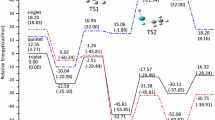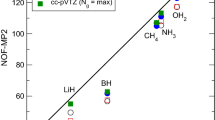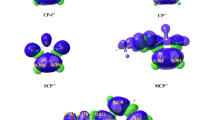Abstract
Nitriles are important chemical species in organic transformations, material chemistry, and environmental sciences. Nitriles are used as cyanating reagents in many organic reactions, where the C–CN bond dissociation has an important role. The reactivity of nitriles can be better understood by studying the bond dissociation energy (BDE) of the C–CN bond. In this benchmark study, homolytic cleavage of the C–CN bond in 12 nitrile compounds is studied. Thirty-one functionals from eight different DFT classes along with three types of basis sets are employed. Theoretical results are compared with the available experimental data. Based on statistical outcomes, the CAM-B3LYP functional of the range separated hybrid GGA class with Pople 6-311G(d,p) basis set provides the most accurate results for calculating the BDE of the C–CN bond. The mean absolute error (MAE) value is 0.06 kcal mol−1, whereas standard deviation (SD) and Pearson’s correlation (R) are 2.79 kcal mol−1 and 0.96, respectively, when compared with experimental data. The substitutional effect on the homolytic cleavage (BDE) of respective bonds in differently substituted nitriles is also investigated. The BDE results indicate that electron withdrawing groups (EWGs) lower the BDE, while electron donating groups (EDGs) increase the BDE of the C–CN bond. The NBO and HOMO–LUMO orbitals analyses are also performed to further elaborate the variational BDE patterns of C–CN bond cleavage.

Benchmark DFT studies on C–CN homolytic cleavage




Similar content being viewed by others
References
Kouznetsov VV, Galvis CEP (2018) Strecker reaction and α-amino nitriles: recent advances in their chemistry, synthesis, and biological properties. Tetrahedron 74:773–810
Zhang J-P, Zheng S-L, Huang X-C, Chen X-M (2004) Two unprecedented 3-connected three-dimensional networks of copper(I) triazolates: in situ formation of ligands by cycloaddition of nitriles and ammonia. Angew Chem Int Ed 43:206–209
Dorsey AD, Barbarow JE, Trauner D (2003) Reductive cyclization of δ-hydroxy nitriles: a new synthesis of glycosylamines. Org Lett 5:3237–3239
Singh R, Sharma R, Tewari N et al (2006) Nitrilase and its application as a “green” catalyst. Chem Biodivers 3:1279–1287
Wakatsuki Y, Yamazaki H (1973) Novel synthesis of heterocyclic compounds from acetylenes. J Chem Soc Chem Commun 280a
Krom MD (1980) Spectrophotometric determination of ammonia: a study of a modified Berthelot reaction using salicylate and dichloroisocyanurate. Analyst 105:305
Goudedranche S, Bugaut X, Constantieux T et al (2014) α,β-unsaturated acyl cyanides as new Bis-electrophiles for enantioselective organocatalyzed formal [3+3]spiroannulation. Chem Eur J 20:410–415
Bobek M, Farkaš J (1969) Nucleic acid components and their analogues. CXXIII. Synthesis of homouridine and homocytidine. Collect Czechoslov Chem Commun 34:1684–1689
Follmann H, Brownson C (2009) Darwin’s warm little pond revisited: from molecules to the origin of life. Naturwissenschaften 96:1265–1292
Fonseca MV, Escalante-Semerena JC (2001) An in vitro reducing system for the enzymic conversion of cobalamin to adenosylcobalamin. J Biol Chem 276:32101–32108
Catak S, D’hooghe M, Verstraelen T et al (2010) Opposite regiospecific ring opening of 2-(Cyanomethyl)aziridines by hydrogen bromide and benzyl bromide: experimental study and theoretical rationalization. J Org Chem 75:4530–4541
Cooper M, Wagner A, Wondrousch D et al (2015) Anaerobic microbial transformation of halogenated aromatics and fate prediction using electron density modeling. Environ Sci Technol 49:6018–6028
Vrábel I, Lukeš V, Laurinc V, Biskupič S (2000) Ab initio study of the Ne( 1 S)−CN( 2 Σ + ) van der Waals complex. J Phys Chem A 104:96–101
Kim H, Cho M (2013) Infrared probes for studying the structure and dynamics of biomolecules. Chem Rev 113:5817–5847
Verdaguer M, Bleuzen A, Marvaud V et al (1999) Molecules to build solids: high TC molecule-based magnets by design and recent revival of cyano complexes chemistry. Coord Chem Rev 190–192:1023–1047
Mallah T, Thiebaut S, Verdaguer M, Veillet P (1993) High-Tc molecular-based magnets: ferrimagnetic mixed-valence chromium(III)-chromium(II) cyanides with Tc at 240 and 190 kelvin. Science (80- ) 262:1554–1557
Holmes SM, Girolami GS (1999) Sol−gel synthesis of KV II [Cr III (CN) 6 ]·2H 2 O: a crystalline molecule-based magnet with a magnetic ordering temperature above 100 °C. J Am Chem Soc 121:5593–5594
Wang B, Hou H, Gu Y (2001) Theoretical study of the reaction of atomic hydrogen with acetonitrile. J Phys Chem A 105:156–164
Anderson RA, Watson AA, Harland WA (1981) Fire deaths in the glasgow area: II the role of carbon monoxide. Med Sci Law 21:288–294
Shang L, Jin L, Dong S (2009) Sensitive turn-on fluorescent detection of cyanide based on the dissolution of fluorophore functionalized gold nanoparticles. Chem Commun 3077
Dar TA, Sankar M (2017) Facile synthesis of nitrovanillin- appended porphyrin and its utilization as potent, recyclable, naked-eye CN − and F − ion sensor. ChemistrySelect 2:6778–6783
Gee H-C, Lee C-H, Jeong Y-H, Jang W-D (2011) Highly sensitive and selective cyanide detection via Cu2+ complex ligand exchange. Chem Commun 47:11963
Chung Y, Ahn KH (2006) N -acyl triazenes as tunable and selective chemodosimeters toward cyanide ion. J Org Chem 71:9470–9474
Zou S, Li R, Kobayashi H et al (2013) Photo-assisted cyanation of transition metal nitrates coupled with room temperature C–C bond cleavage of acetonitrile. Chem Commun 49:1906
Dawson JHJ, Nibbering NMM (1980) The gas-phase anionic chemistry of saturated and unsaturated aliphatic nitriles. Int J Mass Spectrom Ion Phys 33:3–19
Born M, Ingemann S, Nibbering NMM (1996) Experimental determination of the enthalpies of formation of formyl cyanide and thioformyl cyanide in the gas phase. J Phys Chem 100:17662–17669
Frisch MJ, Trucks GW, Schlegel HB, Scuseria GE, Robb MA, Cheeseman JR, Scalmani G, Barone V, Mennucci B, Petersson GA, Nakatsuji H, Caricato M, Li X, Hratchian HP, Izmaylov AF, Bloino J, Zheng G, Sonnenberg JL, Hada M, Ehara M, Toyota K, Fukuda R, Hasegawa J, Ishida M, Nakajima T, Honda Y, Kitao O, Nakai H, Vreven T, Montgomery JA Jr, Peralta JE, Ogliaro F, Bearpark MJ, Heyd J, Brothers EN, Kudin KN, Staroverov VN, Kobayashi R, Normand J, Raghavachari K, Rendell AP, Burant JC, Iyengar SS, Tomasi J, Cossi M, Rega N, Millam NJ, Klene M, Knox JE, Cross JB, Bakken V, Adamo C, Jaramillo J, Gomperts R, Stratmann RE, Yazyev O, Austin AJ, Cammi R, Pomelli C, Ochterski JW, Martin RL, Morokuma K, Zakrzewski VG, Voth GA, Salvador P, Dannenberg JJ, Dapprich S, Daniels AD, Farkas Ö, Foresman JB, Ortiz JV, Cioslowski J, Fox DJ (2010) Gaussian 09 (D01). Gaussian Inc., Wallingford
Millam J, Todd K, Dennington RS (2009) Gauss view 05. Semichem, Inc., Shawnee Mission
Mo Y, Tian G, Car R et al (2016) Performance of a nonempirical density functional on molecules and hydrogen-bonded complexes. J Chem Phys 145:234306
Hirao H (2011) Which DFT functional performs well in the calculation of methylcobalamin? Comparison of the B3LYP and BP86 functionals and evaluation of the impact of empirical dispersion correction. J Phys Chem A 115:9308–9313
Gill PMW, Johnson BG, Pople JA, Frisch MJ (1992) The performance of the Becke—Lee—Yang—Parr (B—LYP) density functional theory with various basis sets. Chem Phys Lett 197:499–505
Riley KE, Op’t Holt BT, Merz KM (2007) Critical assessment of the performance of density functional methods for several atomic and molecular properties. J Chem Theory Comput 3:407–433
Hamprecht FA, Cohen AJ, Tozer DJ, Handy NC (1998) Development and assessment of new exchange-correlation functionals. J Chem Phys 109:6264–6271
Perdew JP, Burke K, Ernzerhof M (1996) Generalized gradient approximation made simple. Phys Rev Lett 77:3865–3868
Dahlke EE, Truhlar DG (2005) Improved density functionals for water. J Phys Chem B 109:15677–15683
Boese AD, Handy NC (2002) New exchange-correlation density functionals: the role of the kinetic-energy density. J Chem Phys 116:9559–9569
Tao J, Perdew JP, Staroverov VN, Scuseria GE (2003) Climbing the density functional ladder: nonempirical meta–generalized gradient approximation designed for molecules and solids. Phys Rev Lett 91:146401
Zhao Y, Lynch BJ, Truhlar DG (2004) Development and assessment of a new hybrid density functional model for thermochemical kinetics. J Phys Chem A 108:2715–2719
Baker J (1986) An algorithm for the location of transition states. J Comput Chem 7:385–395
Adamo C, Barone V (1997) Toward reliable adiabatic connection models free from adjustable parameters. Chem Phys Lett 274:242–250
Lee C, Yang W, Parr RG (1988) Development of the Colle-Salvetti correlation-energy formula into a functional of the electron density. Phys Rev B 37:785–789
Adamo C, Barone V (1998) Exchange functionals with improved long-range behavior and adiabatic connection methods without adjustable parameters: the mPW and mPW1PW models. J Chem Phys 108:664–675
Becke AD (1993) Density-functional thermochemistry. III. The role of exact exchange. J Chem Phys 98:5648–5652
Schmider HL, Becke AD (1998) Optimized density functionals from the extended G2 test set. J Chem Phys 108:9624–9631
Wilson PJ, Bradley TJ, Tozer DJ (2001) Hybrid exchange-correlation functional determined from thermochemical data and ab initio potentials. J Chem Phys 115:9233–9242
Zhao Y, Truhlar DG (2004) Hybrid meta density functional theory methods for thermochemistry, thermochemical kinetics, and noncovalent interactions: the MPW1B95 and MPWB1K models and comparative assessments for hydrogen bonding and van der Waals interactions. J Phys Chem A 108:6908–6918
Xu X, Goddard WA (2004) From the cover: the X3LYP extended density functional for accurate descriptions of nonbond interactions, spin states, and thermochemical properties. Proc Natl Acad Sci 101:2673–2677
Boese AD, Martin JML (2004) Development of density functionals for thermochemical kinetics. J Chem Phys 121:3405–3416
Becke AD (1996) Density-functional thermochemistry. IV. A new dynamical correlation functional and implications for exact-exchange mixing. J Chem Phys 104:1040–1046
Zhao Y, Truhlar DG (2005) Benchmark databases for nonbonded interactions and their use to test density functional theory. J Chem Theory Comput 1:415–432
Zhao Y, Liu J, Li L et al (2005) Role of Ras/PKCζ/MEK/ERK1/2 signaling pathway in angiotensin II-induced vascular smooth muscle cell proliferation. Regul Pept 128:43–50
Chai J-D, Head-Gordon M (2008) Long-range corrected hybrid density functionals with damped atom–atom dispersion corrections. Phys Chem Chem Phys 10:6615
Becke AD (1988) Density-functional exchange-energy approximation with correct asymptotic behavior. Phys Rev A 38:3098–3100
Grimme S (2004) Accurate description of van der Waals complexes by density functional theory including empirical corrections. J Comput Chem 25:1463–1473
Harvey JN (2004) DFT computation of relative spin-state energetics of transition metal compounds. In: Principles and applications of density functional theory in inorganic chemistry I. Structure and bonding, vol 112. Springer, Berlin, pp 151–184
Perdew JP, Parr RG, Levy M, Balduz JL (1982) Density-functional theory for fractional particle number: derivative discontinuities of the energy. Phys Rev Lett 49:1691–1694. https://doi.org/10.1103/PhysRevLett.49.1691
Tawada Y, Tsuneda T, Yanagisawa S et al (2004) A long-range-corrected time-dependent density functional theory. J Chem Phys 120:8425–8433
Yanai T, Tew DP, Handy NC (2004) A new hybrid exchange–correlation functional using the coulomb-attenuating method (CAM-B3LYP). Chem Phys Lett 393:51–57
Ditchfield R, Hehre WJ, Pople JA (1971) Self-consistent molecular-orbital methods. IX. An extended Gaussian-type basis for molecular-orbital studies of organic molecules. J Chem Phys 54:724–728
Dunning TH (1989) Gaussian basis sets for use in correlated molecular calculations. I. The atoms boron through neon and hydrogen. J Chem Phys 90:1007–1023
Tolbatov I, Chipman DM (2014) Comparative study of Gaussian basis sets for calculation of core electron binding energies in first-row hydrides and glycine. Theor Chem Accounts 133:1560
Jensen F (2018) Method calibration or data fitting? J Chem Theory Comput 14:4651–4661
Cheeseman JR, Frisch MJ, Devlin FJ, Stephens PJ (2000) Hartree−fock and density functional theory ab initio calculation of optical rotation using GIAOs: basis set dependence. J Phys Chem A 104:1039–1046
Bjornsson R, Arnason I (2009) Conformational properties of six-membered heterocycles: accurate relative energy differences with DFT, the importance of dispersion interactions and silicon substitution effects. Phys Chem Chem Phys 11:8689
Weigend F, Ahlrichs R (2005) Balanced basis sets of split valence, triple zeta valence and quadruple zeta valence quality for H to Rn: design and assessment of accuracy. Phys Chem Chem Phys 7:3297
Geerlings P, De Proft F, Langenaeker W (2003) Conceptual density functional theory. Chem Rev 103:1793–1874
Bland JM, Altman DG (1996) Statistics notes: measurement error and correlation coefficients. BMJ 313:41–42
Hyndman RJ, Koehler AB (2006) Another look at measures of forecast accuracy. Int J Forecast 22:679–688
Tsipis AC (2014) DFT flavor of coordination chemistry. Coord Chem Rev 272:1–29
Luo Y-R (2007) Comprehensive hand book of chemical bond energies. Taylor & Francis, London
Mezei PD, Csonka GI, Kállay M (2015) Accurate Diels–Alder reaction energies from efficient density functional calculations. J Chem Theory Comput 11:2879–2888
Acknowledgments
The authors acknowledge the Higher Education Commission Pakistan (HEC) (Grant no. 3013 and 5309) and COMSATS University, Abbottabad campus for financial support.
Author information
Authors and Affiliations
Corresponding authors
Ethics declarations
Conflict of interest
The authors declare no conflict of interest.
Additional information
Publisher’s note
Springer Nature remains neutral with regard to jurisdictional claims in published maps and institutional affiliations.
Electronic supplementary material
ESM 1
(DOCX 24973 kb)
Rights and permissions
About this article
Cite this article
Kosar, N., Ayub, K., Gilani, M.A. et al. Benchmark DFT studies on C–CN homolytic cleavage and screening the substitution effect on bond dissociation energy. J Mol Model 25, 47 (2019). https://doi.org/10.1007/s00894-019-3930-x
Received:
Accepted:
Published:
DOI: https://doi.org/10.1007/s00894-019-3930-x




